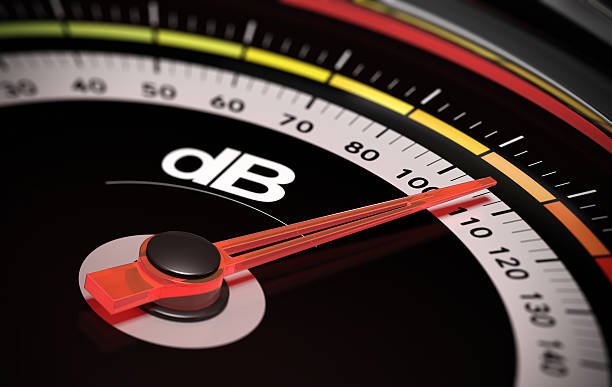The Decibel Scale - A Guide
Every day we are surrounded by sounds. From the sound of light rain to the roaring blast of a jet engine, our ears pick up a vast range of noises. But have you ever wondered how these sounds are measured?
This guide will introduce you to the world decibels which are the universal unit for measuring sound intensity. We’ll talk about their use, their history, how they are used and what constitutes safe or harmful levels for our ears. But, more importantly how to prevent damage to our hearing from exposure to loud noises.
What is a "decibel" and what are decibels used for?
The concept of the decibel was born in the 20th century within the ‘Bell System’ in the United States of America, where it was used to measure power and transmission loss in the telephony industry. This term was coined by telephone engineers to express the effectiveness of telephone circuits. The term ‘Decibel’ is a combination of ‘Deci’ meaning tenth, and ‘bel’ in honour of the inventor of the telephone Alexander Graham Bell.
A Decibel (dB) is a unit that quantifies the intensity or power level of a sound or signal. It signifies the logarithmic ratio of a value that has been measured to a reference value, which is usually the threshold of human hearing. Decibels act as a global standard for quantifying the intensity of sound, encompassing the extensive spectrum of sounds that can be perceived by the human ear.
How are sound decibels measured?
Decibels are measured using a sound level meter (otherwise known as a decibel meter). This device captures the sound, then converts the sound waves into electrical signals, it then uses the logarithmic scale to convert this into a reading on the decibel scale. A logarithmic scale is a non-linear scale where each increment on the scale represents a multiplication of a constant factor. In this case each time a sounds decibel level increases by 10 its intensity multiplies by 10.
dB = 10 * log (P1 / Pr)
The decibel scale starts from the smallest audible sound (almost silent), this would be represented as 0dB, a sound 10 times more powerful that 0dB would be 10dB, a sound 100 times more powerful than would be 20dB and a sound 1000 times more powerful would be 30Db.
What is considered a harmful decibel level?
Harmful decibel levels are 85dB and over, prolonged exposure to sounds registering 85dB or higher can cause irreparable damage to your hearing. Sounds registering over 120dB can cause discomfort and over 140dB can cause pain in the ear.
What is considered a safe decibel level?
Safe decibels levels are sounds which fall at or below 70dB. This is the sound level of two people having a normal conversation.
What is the legal decibel level in the UK?
In the UK the legal decibel level varies depending on context:
Residential noise – Residential noise refers to noise that could be considered a nuisance. For noise to be considered a nuisance it must interfere with the use or enjoyment of your home or injure health or be likely to injure health. After 11pm permitted noise levels are 34dB and under.
Workplace noise – There are regulations within the workplace to ensure that workers hearing is protected from excessive noise at work. The level of noise exposure in which employers must provide hearing protection is 85dB and an exposure limit with hearing protection of 87dB.
Music & event noise – Most music events are capped between 75dB to 85dB. However, this can vary depending on location, local authority and duration of the event.
Examples of Decibel Volumes:
0-10dB – Almost silent - normal breathing.
10-50dB – Mosquito buzzing - light rainfall
50-80dB - Electric toothbrush - Alarm Clock
80-100dB – Vacuum Cleaner - Tractor
100-120dB – Baby Crying - Ambulance Siren
120-150dB – Power Drill - Jet Engine taking off
150dB+ - Rocket launching from Pad.
What's the loudest decibel volume ever recorded?
The loudest recorded sound was a whopping 310dB caused by an erupting volcano in Krakatoa in 2009.
How should I protect my ears from harmful decibel levels?
To protect your ears, it is suggested to use earplugs or noise cancelling headphones when exposed to harmful levels (over 85dB). It is also advised to limit your time in noisy environments and to keep headphone and music levels low on personal devices.
How can I fix my ears when exposed to harmful decibel levels?
Unfortunately, there is no fix for damage caused by exposure to harmful decibel levels. Loud noise is particularly harmful to the inner ear, exposure to an extremely loud sound or prolonged exposure can damage the cells and membrane within the inner ear and it can overwork the cells in the ear causing them to die. The can result in hearing loss and tinnitus. The best way to avoid this it to take preventative steps to protect your ears.
Turn the volume down – turning the volume down on the TV, headphones and whilst listening to music.
Avoid noisy environments – If you are in a loud environment and it is unavoidable, give your ears breaks by going outside/somewhere quieter regularly throughout your time there.
Use hearing protection – the most effective way to prevent hearing loss or damage to your ears is to use noise cancelling headphones or ear plugs when in loud places.
Understanding decibels and their impact on our hearing is crucial for maintaining good hearing health. By being aware of decibel levels of the sounds around us, we can take steps to protect our ears and prevent any potential hearing loss.


